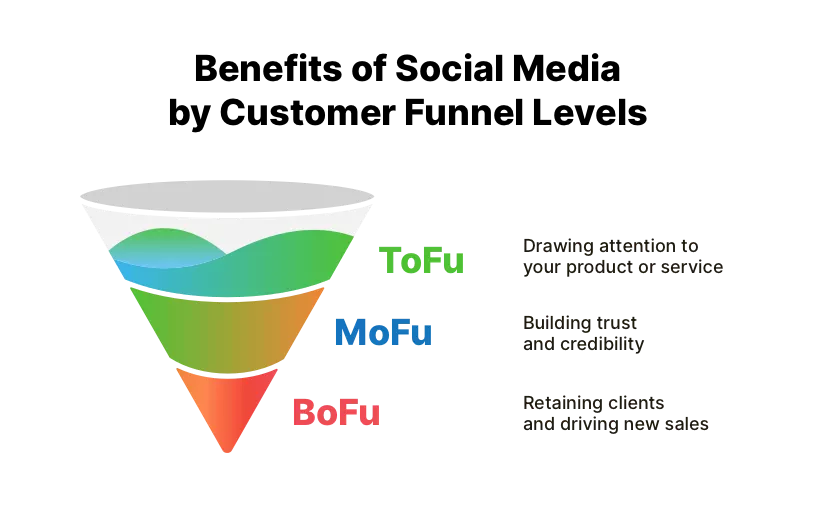As a business owner or someone planning to launch a startup, you may wonder if you need social media accounts. Even if you already have them, you might still question their necessity. Let’s explore this topic and provide some clarity.
In 2023, 4.9 billion people used social media across the world – 61.4% of the global population. Impressive? Huh! But do you need this audience?
Social media is just one channel through which you can communicate with your customers. Other channels include offline methods like your physical store, print materials, out-of-home advertising, websites, mobile ads, messengers, phone calls, and more.
The first question to ask yourself is whether you need an online presence at all. If you run a fully offline business, such as a convenience store or a deli shop, you might wonder why you would ever need anything online.
Think about your audience and how they want to talk to you. Would they need to interact with you via their mobile phones or laptops? Would they want to subscribe to your online channel? Do you have something to tell them there?
If the answer is yes, then surely you do need something online.

Your website would be like a store or building that you own. It is not easy for your audience to find your store. But if they get in – they are all yours, playing your rules.
As for a social media account, think of it as a rented booth on a large crowded street – huge potential reach is already there but you’re playing by the rules of this street.
The one who ignites the crowd – gets their attention.
Your business could potentially impress millions of people worldwide just by leveraging digital channels. Let’s think about how you can do it properly.
Each platform, like LinkedIn, X (Twitter), Facebook, Instagram, and TikTok, serves different audience demographics and marketing needs. Your goal is to find the best overlap of their audience with your primary target market.
| Platform | Typical Audience | Content Strategy |
|---|---|---|
| Professionals across industries, job seekers, and recruiters. Strong focus on career development. | Thought leadership articles, industry news, company updates, job postings. | |
| Broad demographics, biased slightly older (30s to 60s). Interests range widely depending on individual communities. | Engaging posts, a mix of personal and professional updates, longer-form text, images, and videos. | |
| X (Twitter) | Diverse, but attracts those interested in news, current events, pop culture, and quick commentary. | Short, snappy text updates, news, memes, viral content, conversational threads. |
| YouTube | Huge range, massive appeal across demographics for entertainment, education, and information. | How-to videos, product reviews, vlogs, creative video content of all kinds. |
| Telegram | Privacy-focused users, groups interested in cryptocurrency, tech-savvy communities. | Group chats, secure messaging, broadcast channels for disseminating information. |
| Primarily women with interests in DIY, home decor, recipes, fashion, and lifestyle. | High-quality visuals are key! Inspirational images, infographics, product demonstrations. | |
| Younger demographic (teens to 30s), favors lifestyle content, fashion, beauty, travel. | Visually captivating photos and videos (Reels are vital), Stories, influencer partnerships. | |
| TikTok | Heavily favors Gen Z and younger millennials. Interests in trends, music, dance, viral humor. | Short, highly engaging videos with a focus on entertainment, challenges, and catchy audio. |
Keep in mind that these are just generalizations. It’s not like TikTok is a no-go zone for oldies and Telegram is not for foodies.
To choose the best platform for your business, consider these tips:
Do your homework on your target audience, see if there’s any overlap, and don’t be afraid to use multiple platforms.
Brands and social media are pretty much inseparable. It makes brand consistency crucial for establishing a recognizable and trusted brand identity. (Read more about Branding and Consistency)
When someone strolls by your booth on the street and decides to pop into your shop, they naturally expect the same vibe, level of quality, tone, and offerings to be consistent, right?
Here are quick tips to ensure consistency in your social media efforts:
The visuals on your business profiles are like the first impression you make on your followers. They play a big role in making sure people remember who you are. These elements must be aligned across all platforms:
Treat your bio like an elevator pitch. It should quickly and clearly highlight what distinguishes your business, whether that’s a unique product, exceptional service, or a specific niche.
When they see your booth for the first time they would ask: “Is this thing ever for me?”
Help them answer this question.
The street’s rules are tough: space is limited, and the audience has only two seconds to catch the idea.
Before you go live on social media, figure out what you want to get out of it. Do you want people to know your brand better (brand awareness), visit your website, or buy your stuff?

How can you benefit from having a booth on a crowded street:
We may sound like a broken record here but again, think of your audience:
What kind of stuff would they like to read or watch that you make? What would entertain or educate them or help them solve their problems?
Just posting on social media isn’t enough; you need to make sure it helps your audience – and thus, your business. If not, you’re wasting your time. Ideally, you would need to come up with tables and formulas showing you how:
SMART goal framework helps a lot:
You will criticize us for being controversial. But ‘No Goal’ is also a goal.
Sometimes, it can be helpful to just jump in and start posting without a set goal. Particularly for new businesses that are still finding their way. Improvise, play around and post whatever you want and whatever you find interesting.
This flexibility and creativity can help you figure out what works and what doesn’t, which can spark your next idea.
Not every business needs a social media account (or a website). But for some of them, big or small, social media marketing can be a huge plus! It’s like setting up a booth on a huge crowded street and getting visibility, engagement, and sales—all in one place.
First things first, think of what your audience needs and where they need it. Select the right platform. Be consistent and recognizable. Set clear goals but don’t be afraid to break them sometimes. In the following article, we will discuss the next-level content strategies for social media. We’ll jump into how to plan and produce content, and how to be authentic, honest, and disciplined while communicating to your subscribers.
Do, Measure, Adjust, and Repeat – and your audience will be there for you.

Email subscription is available ONLY TODAY (oh, okay, and tomorrow).
Surely, we respect your inbox! Unsubscription works every day.

We’d love to tailor your experience — which of these best describes you?